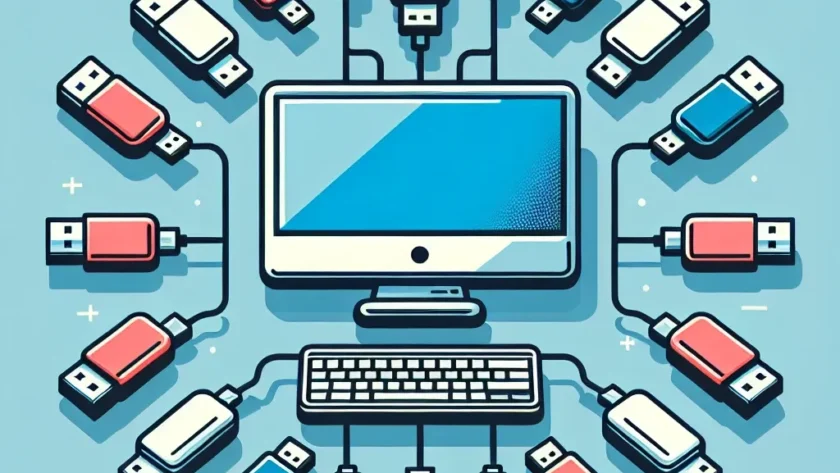Introduction
In today’s digital age, the need for data storage and transfer is constantly evolving. One of the most popular devices for this task is the USB flash drive. With their compact size and ease of use, these drives have become a staple in our daily tech routines. However, as we accumulate more flash drives, the question arises: Can a USB hub connect multiple flash drives to one computer? The simple answer is yes. But let’s dive deeper into how this works, the types of USB hubs available, and the implications of connecting multiple devices.
Understanding USB Hubs
A USB hub is a device that expands a single USB port into several USB ports, allowing multiple devices to be connected to one computer simultaneously. Most hubs are designed to make it easy to connect a variety of USB devices including mice, keyboards, and of course, flash drives.
Types of USB Hubs
There are two main types of USB hubs available on the market:
- Passive USB Hubs: These hubs do not need an external power source and operate using the power provided by the computer’s USB port. They are typically used for low-power devices.
- Active USB Hubs: These hubs require an external power source and are designed to support multiple high-powered devices. They are ideal for connecting several flash drives and other peripherals simultaneously without overloading the system.
Key Specifications of USB Hubs
| Specification | Description |
|---|---|
| USB Version | Refers to the data transfer speed capability (USB 2.0, 3.0, 3.1, etc.). USB 3.0 and higher offer faster speeds. |
| Number of Ports | The total number of USB ports available on the hub. |
| Power Supply | Whether the hub is passive or active, and its power requirements. |
| Data Transfer Rate | The maximum speed at which data can be transferred through the hub. |
| Compatibility | Check for compatibility with different operating systems (Windows, macOS, Linux). |
How to Connect Multiple Flash Drives Through a USB Hub
Connecting multiple flash drives to a computer via a USB hub is straightforward. Follow these steps:
- Choose the right USB hub based on the number of flash drives you plan to connect and their power requirements.
- Connect the USB hub to your computer through an available USB port.
- Plug the flash drives into the hub’s available ports.
- Ensure the computer recognizes all the connected devices. This can often be checked through the ‘This PC’ section in Windows or ‘Finder’ on macOS.
Once connected, you should be able to transfer and manage files on all the flash drives concurrently, enhancing productivity.
Benefits of Using a USB Hub
Using a USB hub to connect multiple flash drives to a single computer has several benefits:
- Convenience: Easily connect multiple devices without the need for constant plugging and unplugging.
- Space Saving: Consolidate the number of cords and devices needed while maximizing your connectivity options.
- Enhanced Productivity: Switch between multiple drive contents quickly, allowing for greater efficiency in tasks.
Considerations and Limitations
While USB hubs offer many advantages, there are some considerations to keep in mind:
Data Transfer Speeds
The data transfer speed may be reduced when using a hub, especially if multiple devices are active simultaneously. For instance, when using a USB 2.0 hub compared to a USB 3.0 hub, the speed could be significantly slower, as USB 2.0 has a maximum transfer rate of 480 Mbps, while USB 3.0 supports up to 5 Gbps.
Power Distribution
In passive hubs, power is shared among all connected devices. This means that if you’re using multiple high-capacity flash drives, they may not receive adequate power, leading to errors. Active hubs typically provide power to each port, mitigating this issue.
Driver Compatibility
Occasionally, certain hubs may require specific drivers, especially for older or specialized USB versions. Always check for compatibility with your operating system.
Common Use Cases for USB Hubs
There are various scenarios where leveraging a USB hub for multiple flash drives can be beneficial:
- Data Backup: Users can connect several flash drives to back up important files quickly.
- Media Transfer: Photographers can quickly offload pictures from multiple cards.
- File Sharing: Collaborate with team members by connecting multiple drives for easier file exchange.
Conclusion
In conclusion, using a USB hub to connect multiple flash drives to one computer is an efficient way to manage your data storage needs. With the right hub, you can enhance your workflow, save space, and simplify the management of your digital files. However, it’s essential to be mindful of potential limitations such as power distribution and data transfer speeds. By selecting the appropriate USB hub and understanding its functionalities, you can make the most out of your USB connections.
FAQs
Can I use a USB hub with a powered USB hub and a passive USB hub together?
Yes, most computers can support both active and passive hubs together, but ensure you are not exceeding power limits.
Will using a USB hub reduce the read/write speeds of my flash drives?
Potentially, yes. If multiple drives are transferring data simultaneously on a USB 2.0 hub, you may notice reduced speeds.
Can I connect more than one hub to my computer?
Yes, you can daisy-chain multiple USB hubs to expand your connectivity, but performance may vary depending on the total number of devices.

